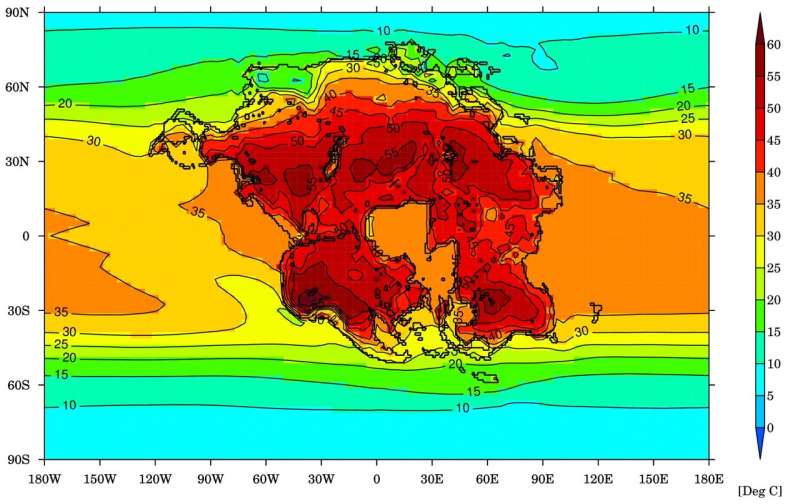This article has been reviewed according to Science X's editorial process and policies. Editors have highlighted the following attributes while ensuring the content's credibility:
fact-checked
peer-reviewed publication
trusted source
proofread
New research reveals extreme heat likely to wipe out humans and mammals in the distant future

A new study shows unprecedented heat is likely to lead to the next mass extinction since the dinosaurs died out, eliminating nearly all mammals in some 250 million years time.
The research, published in Nature Geoscience and led by the University of Bristol, presents the first-ever supercomputer climate models of the distant future and demonstrates how climate extremes will dramatically intensify when the world's continents eventually merge to form one hot, dry and largely uninhabitable supercontinent.
The findings project how these high temperatures are set to further increase, as the sun becomes brighter, emitting more energy and warming the Earth. Tectonic processes, occurring in the Earth's crust and resulting in supercontinent formation would also lead to more frequent volcanic eruptions which produce huge releases of carbon dioxide into the atmosphere, further warming the planet.
Mammals, including humans, have survived historically thanks to their ability to adjust to weather extremes, especially through adaptations such as fur and hibernating in the cold, as well as short spells of warm weather hibernation.
While mammals have evolved to lower their cold temperature survivable limit, their upper temperature tolerance has generally remained constant. This makes exposure to prolonged excessive heat much harder to overcome and the climate simulations, if realized, would ultimately prove unsurvivable.
Lead author Dr. Alexander Farnsworth, Senior Research Associate at the University of Bristol, said, "The newly-emerged supercontinent would effectively create a triple whammy, comprising the continentality effect, hotter sun and more CO2 in the atmosphere, of increasing heat for much of the planet. The result is a mostly hostile environment devoid of food and water sources for mammals.
"Widespread temperatures of between 40 to 50° Celsius, and even greater daily extremes, compounded by high levels of humidity would ultimately seal our fate. Humans—along with many other species—would expire due to their inability to shed this heat through sweat, cooling their bodies."
Although human-induced climate change and global warming is likely to be a growing cause of heat stress and mortality in some regions, research suggests the planet should largely remain habitable until this seismic landmass change in the deep future. But when the supercontinent forms, findings indicate only somewhere between 8% and 16% of land would be habitable for mammals.

Co-author Dr. Eunice Lo, Research Fellow in Climate Change and Health at the University of Bristol said, "It is vitally important not to lose sight of our current Climate Crisis, which is a result of human emissions of greenhouse gases. While we are predicting an uninhabitable planet in 250 million years, today we are already experiencing extreme heat that is detrimental to human health. This is why it is crucial to reach net-zero emissions as soon as possible."
The international team of scientists applied climate models, simulating temperature, wind, rain, and humidity trends for the next supercontinent—called Pangea Ultima—expected to form in the next 250 million years. To estimate the future level of CO2 the team used models of tectonic plate movement, ocean chemistry and biology to map out inputs and outputs of CO2.
The future CO2 calculations were led by Professor Benjamin Mills at the University of Leeds, who said, "We think CO2 could rise from around 400 parts per million (ppm) today to more than 600 ppm many millions of years in the future. Of course, this assumes that humans will stop burning fossil fuels, otherwise we will see those numbers much, much sooner."
Dr. Farnsworth, also a visiting Professor at the Tibetan Plateau Earth System, Environment and Resources (TPESER), at the Chinese Academy of Sciences Institute of Tibetan Plateau Research said, "The outlook in the distant future appears very bleak. Carbon dioxide levels could be double current levels. With the sun also anticipated to emit about 2.5% more radiation and the supercontinent being located primarily in the hot, humid tropics, much of the planet could be facing temperatures of between 40 to 70°C.
"This work also highlights that a world within the so-called 'habitable zone' of a solar system may not be the most hospitable for humans depending on whether the continents are dispersed, as we have today, or in one large supercontinent."
In addition, the research illustrates the importance of tectonics and continental layouts when conducting research into planets beyond our solar system, called exoplanets.
Although the Earth will still be within the habitable zone in 250 million years' time, for mammals the formation of a supercontinent with elevated carbon dioxide will make most of the world uninhabitable. The findings suggest the landmass layout for a distant world could be a key factor when determining how livable it is for humans.
More information: Alexander Farnsworth, Climate extremes likely to drive land mammal extinction during next supercontinent assembly, Nature Geoscience (2023). DOI: 10.1038/s41561-023-01259-3. www.nature.com/articles/s41561-023-01259-3
Journal information: Nature Geoscience
Provided by University of Bristol




















